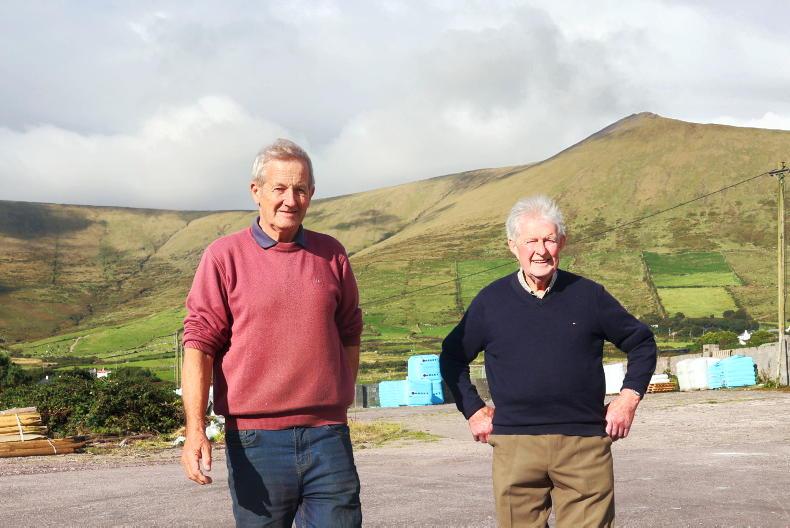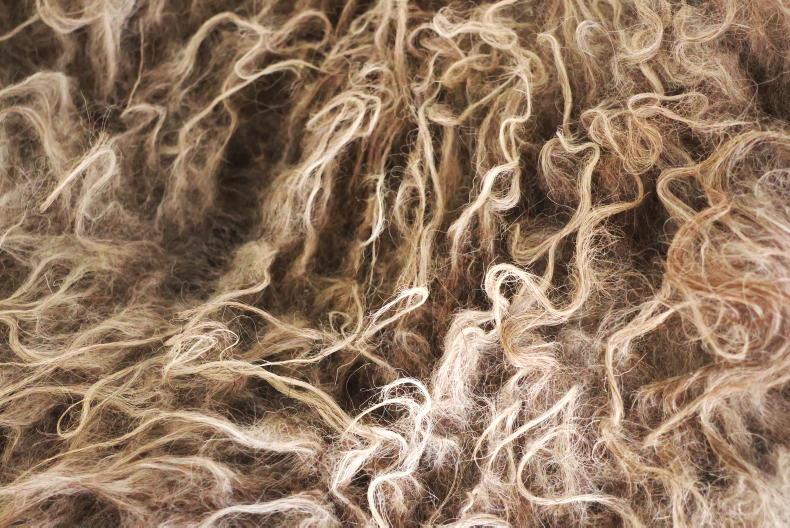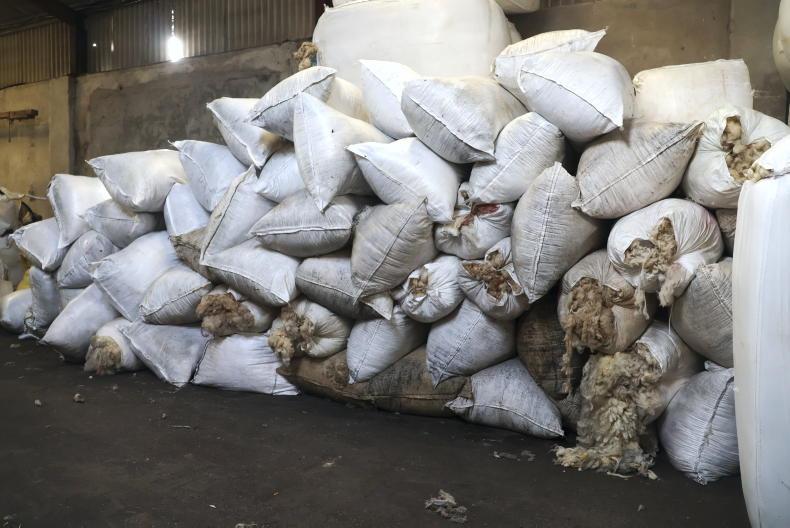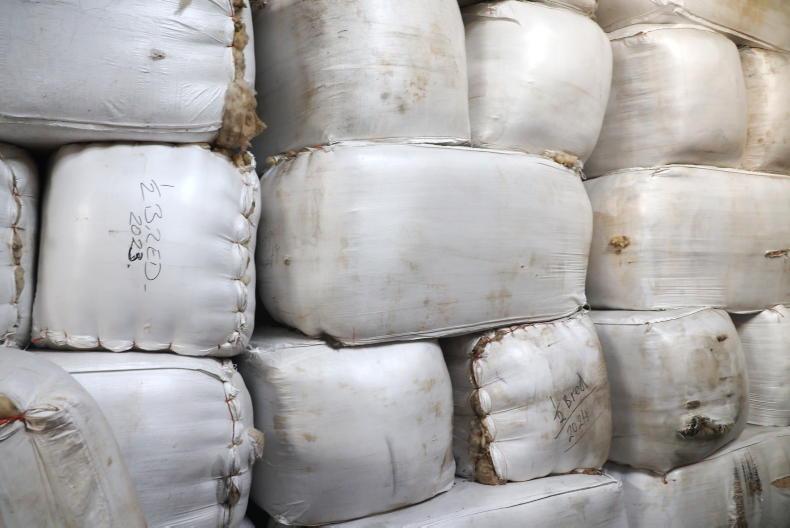The story of the Kerry Lamb and Wool Co-op, or Comharchumann Uan Chiarraí Teo to give it its proper title, resembles the terrain of west Kerry itself.
It has experienced peaks and troughs throughout its 50 years in existence that resemble the Slieve Mish Mountains that run throughout the Dingle peninsula.
“We definitely made mistakes, but we must have done something right the fact we’re still here,” said general manager, Séan Moriarty.
“Today, the whole scene is looking much different. Numbers are being curtailed. Every sheep less, means less wool, less doses, less feed, less fertiliser. The nitrates thing is only starting to kick in. I was making calls for the last run of fertiliser and farmers are telling me they’d love to spread more but they can’t. So, this year, that is biting harder. We have to look at other areas if we are to survive,” he told the Irish Farmers Journal.
Every load that leaves the premises in Baile na hAbha, Lios Póil (Ballynahow, Lispole) for the UK contains 100 bales of wool. The bales weigh 250kg and contain about 20,000 fleeces each.
“We’d have the different types. Blacks and greys, Mayo, Scotch, half-bred and then it’s put into bales. Since we started, the breeds have changed in the locality. In 1974, 99% of the sheep around here were Mountain Blackface and the sheep would have been kept for their wool.
“Wether lambs were kept until they were three-year-olds but it would justify keeping them for another year for the wool. They would have been shorn twice.”
The co-op was formed from an existing west Kerry sheep farmers’ organisation. James Brosnan has been chair since day one.
“It started as a lamb fattening operation and the economics didn’t go very well for fattening lamb, so it evolved.

James Brosnan and Sean Moriarty of the Kerry Lamb and Wool Co-op at Baile na Habha, Lios Póil.
“We moved into wool and developed other services for all farmers; like we put a van on the road selling veterinary supplies and moved into feed, fertiliser and farm supplies too.
“The devaluation of the wool has been the biggest setback we’ve had. When a man brought in a load of wool, it brought a lot of stuff. It collected a certain amount of money all the time. When that went, it got harder still.”

Sean Moriarty at the wool baler in the wool shed of Kerry Lamb and Wool Co-op.
The idea to go lamb fattening was a new venture, Moriarty said.
“Most people kept sheep until they were three-year-old wethers.
“There was no such thing as lamb. The first lambs that were ever killed out of here were after we had started.
“At the time, the price of a mountain lamb was from £2 up to £7. We heard that we could try to fatten lambs inside and the theory was if it was tried properly it could go to the French market.”

A coarse fleece taken from a Scotch sheep. If it's mixed in with finer wool it creates extra work for Kerry Lamb and Wool Co-op as they need to separate the different types of fleece.
A similar fattening operation began the year before in Cornamona, Co Galway, so James and three others took a trip up by car to see it.
“Four of us went in the car and when we went in, it was the first time saw lambs inside.”
They also gave the new manager of the Galway co-op, future Cabinet Minister, Éamon Ó Cuív, his first sale.
“I liked what I saw in a ram lamb in the shed, so I bought him and we tied his legs and put him in the boot of the car and brought him home,” Brosnan said.
Having seen what was happening in Galway, they reported back to a meeting and a decision was made to form a co-op and to buy a site to build a lamb fattening house.

Bags of wool which must be sorted through at Kerry Lamb and Wool Co-op.
A meeting was called on their return and they went about gathering share capital. For every pound a farmer put in, they secured a space for a lamb, with a minimum of £30 required.
“After the first meeting we came away with £7,500. We secured a government grant of 70% for the building, but it was going to cost £100,000 to do all the building work. We managed to bridge the gap and we took in 800 lambs that first day just before Christmas 1974,” Brosnan said.
The economics of fattening lamb, combined with high interest rates in the early 1980s in excess of 20%, saw lamb fattening cease eight years later. The co-op ended up selling the buildings and some land before buying them back a decade later.

The bales of wool are shipped to Bradford in the UK for further processing.
“The big problem was the factories. They wouldn’t quote you a price on Friday evening in for Monday morning. It was like putting money on a horse,” Moriarty added.
“That was our downfall. You had hundreds of thousands of pounds in the shed down there and the cost to keep them could end up being below their value. That’s hard enough to do when you have a reserve built up but we were doing it on borrowed money.”

James Brosnan in the wool shed at Kerry Lamb and Wool Co-op.
“The market seems to be a small bit better,” Moriarty said.
“The sales in the UK seem to be going a little bit better. The big problem really is there is more wool available than there is demand for.
“It’s very simple, we’re all to blame. People aren’t wearing wool, it’s all synthetics we’re wearing. We could solve the Irish problem overnight.
“There are about 6m kilogrammes of wool shorn in the 26 counties and about 5m people, so if everyone bought 1kg of wool in the year we’d be self-sufficient.

The bales of wool which weigh about 250kg each are put into bales of similar class wool.
“Insulation is the instant one that there would be merit in.
“If the Government comes on board and stipulates the use of wool-based insulation that would be a huge plus because they’re going to be building so many houses in the next few years.
“More wool insulation is being made and it would help. Composting is being looked at too but it’s at the lower of the market.
“The co-op has constantly evolved as markets and policy changed. Meeting farmers, you could have a full range of veterinary products at the time. Get into yards and meet people.
“The age profile of farmers and more regulations, especially since Brexit, are the two things that are the bane of our lives. Every regulation is a cost. It’s more paperwork and you nearly have to have clearance now before it leaves the store.
“Next stop after us is to wash the wool, so we’d be delivering the wool into the scouring plant in the UK in Bradford,” he said.
The story of the Kerry Lamb and Wool Co-op, or Comharchumann Uan Chiarraí Teo to give it its proper title, resembles the terrain of west Kerry itself.
It has experienced peaks and troughs throughout its 50 years in existence that resemble the Slieve Mish Mountains that run throughout the Dingle peninsula.
“We definitely made mistakes, but we must have done something right the fact we’re still here,” said general manager, Séan Moriarty.
“Today, the whole scene is looking much different. Numbers are being curtailed. Every sheep less, means less wool, less doses, less feed, less fertiliser. The nitrates thing is only starting to kick in. I was making calls for the last run of fertiliser and farmers are telling me they’d love to spread more but they can’t. So, this year, that is biting harder. We have to look at other areas if we are to survive,” he told the Irish Farmers Journal.
Every load that leaves the premises in Baile na hAbha, Lios Póil (Ballynahow, Lispole) for the UK contains 100 bales of wool. The bales weigh 250kg and contain about 20,000 fleeces each.
“We’d have the different types. Blacks and greys, Mayo, Scotch, half-bred and then it’s put into bales. Since we started, the breeds have changed in the locality. In 1974, 99% of the sheep around here were Mountain Blackface and the sheep would have been kept for their wool.
“Wether lambs were kept until they were three-year-olds but it would justify keeping them for another year for the wool. They would have been shorn twice.”
The co-op was formed from an existing west Kerry sheep farmers’ organisation. James Brosnan has been chair since day one.
“It started as a lamb fattening operation and the economics didn’t go very well for fattening lamb, so it evolved.

James Brosnan and Sean Moriarty of the Kerry Lamb and Wool Co-op at Baile na Habha, Lios Póil.
“We moved into wool and developed other services for all farmers; like we put a van on the road selling veterinary supplies and moved into feed, fertiliser and farm supplies too.
“The devaluation of the wool has been the biggest setback we’ve had. When a man brought in a load of wool, it brought a lot of stuff. It collected a certain amount of money all the time. When that went, it got harder still.”

Sean Moriarty at the wool baler in the wool shed of Kerry Lamb and Wool Co-op.
The idea to go lamb fattening was a new venture, Moriarty said.
“Most people kept sheep until they were three-year-old wethers.
“There was no such thing as lamb. The first lambs that were ever killed out of here were after we had started.
“At the time, the price of a mountain lamb was from £2 up to £7. We heard that we could try to fatten lambs inside and the theory was if it was tried properly it could go to the French market.”

A coarse fleece taken from a Scotch sheep. If it's mixed in with finer wool it creates extra work for Kerry Lamb and Wool Co-op as they need to separate the different types of fleece.
A similar fattening operation began the year before in Cornamona, Co Galway, so James and three others took a trip up by car to see it.
“Four of us went in the car and when we went in, it was the first time saw lambs inside.”
They also gave the new manager of the Galway co-op, future Cabinet Minister, Éamon Ó Cuív, his first sale.
“I liked what I saw in a ram lamb in the shed, so I bought him and we tied his legs and put him in the boot of the car and brought him home,” Brosnan said.
Having seen what was happening in Galway, they reported back to a meeting and a decision was made to form a co-op and to buy a site to build a lamb fattening house.

Bags of wool which must be sorted through at Kerry Lamb and Wool Co-op.
A meeting was called on their return and they went about gathering share capital. For every pound a farmer put in, they secured a space for a lamb, with a minimum of £30 required.
“After the first meeting we came away with £7,500. We secured a government grant of 70% for the building, but it was going to cost £100,000 to do all the building work. We managed to bridge the gap and we took in 800 lambs that first day just before Christmas 1974,” Brosnan said.
The economics of fattening lamb, combined with high interest rates in the early 1980s in excess of 20%, saw lamb fattening cease eight years later. The co-op ended up selling the buildings and some land before buying them back a decade later.

The bales of wool are shipped to Bradford in the UK for further processing.
“The big problem was the factories. They wouldn’t quote you a price on Friday evening in for Monday morning. It was like putting money on a horse,” Moriarty added.
“That was our downfall. You had hundreds of thousands of pounds in the shed down there and the cost to keep them could end up being below their value. That’s hard enough to do when you have a reserve built up but we were doing it on borrowed money.”

James Brosnan in the wool shed at Kerry Lamb and Wool Co-op.
“The market seems to be a small bit better,” Moriarty said.
“The sales in the UK seem to be going a little bit better. The big problem really is there is more wool available than there is demand for.
“It’s very simple, we’re all to blame. People aren’t wearing wool, it’s all synthetics we’re wearing. We could solve the Irish problem overnight.
“There are about 6m kilogrammes of wool shorn in the 26 counties and about 5m people, so if everyone bought 1kg of wool in the year we’d be self-sufficient.

The bales of wool which weigh about 250kg each are put into bales of similar class wool.
“Insulation is the instant one that there would be merit in.
“If the Government comes on board and stipulates the use of wool-based insulation that would be a huge plus because they’re going to be building so many houses in the next few years.
“More wool insulation is being made and it would help. Composting is being looked at too but it’s at the lower of the market.
“The co-op has constantly evolved as markets and policy changed. Meeting farmers, you could have a full range of veterinary products at the time. Get into yards and meet people.
“The age profile of farmers and more regulations, especially since Brexit, are the two things that are the bane of our lives. Every regulation is a cost. It’s more paperwork and you nearly have to have clearance now before it leaves the store.
“Next stop after us is to wash the wool, so we’d be delivering the wool into the scouring plant in the UK in Bradford,” he said.













 This is a subscriber-only article
This is a subscriber-only article









SHARING OPTIONS: